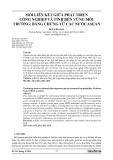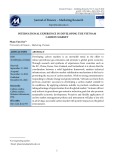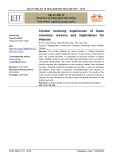VNU Journal of Economics and Business, Vol. 4, No. 2 (2024) 12-22
VNU Journal of Economics and Business
Journal homepage: https://jeb.ueb.edu.vn
Original Article A comparative empirical analysis of Miller and Modigliani’s Dividend Irrelevance Theory in Vietnam and Singapore
Le Hong Khanh Ngoc1, Tran Viet Dung2,*
1Aalto University, Otakaari 24, 02150 Espoo, Finland 2VNU University of Economics and Business No. 144 Xuan Thuy Street, Cau Giay District, Hanoi, Vietnam
Received: March 12, 2024 Revised: March 27, 2024; Accepted: April 25, 2024
Abstract: This study aims to assess the applicability of Miller and Modigliani’s Dividend Irrelevance Theory in Vietnam and Singapore from 2018 to 2022. By comparing and contrasting results from the two markets, the research seeks to offer insights into potential similarities and differences, enriching academic understanding while providing valuable, updated information for executives and investors for informed dividend and investment decision-making. Using data from the VN30 index of Vietnam and STI index of Singapore, including variables such as stock price, dividends per share, earnings per share, and total assets, the study employs regression analysis with fixed effects models to examine the relationship between dividends and firm values. The analysis indicates a significant relationship between a firm’s dividend policy and its market value, though the impact is negative in Vietnam but positive in Singapore. Additionally, earnings per share is found to positively affect share prices in both markets. As such, the validity of Miller and Modigliani’s Dividend Irrelevance proposition during the study period is challenged.
Keywords: Dividend policy, market value, stock price, Dividend Irrelevance Theory, Vietnam, Singapore.
1. Introduction*
A company’s dividend policy, a critical component of corporate financial management, is of great concern to managers, shareholders, and investors. As it delineates how profits are distributed between dividends and retained earnings, a robust dividend policy conveys the financial health of the company, fostering positive relations with shareholders. From the stakeholders’ perspective, dividend policy aids in assessing a company’s financial status and risk profile. Dividends are not only a source of reliable measure of income but also a performance due to their less susceptibility to accounting irregularities. They also helps lower portfolio risk by mitigating losses from falls in stock prices. Research suggests dividend-paying
Licensing: This article is published under a CC BY-NC 4.0 license.
________ * Corresponding author E-mail address: dung_tv@vnu.edu.vn https://doi.org/10.57110/vnujeb.v2i6.272 Copyright © 2024 The author(s)
12
L.H.K. Ngoc, T.V. Dung / VNU Journal of Economics and Business, Vol. 4, No. 2 (2024) 12-22
13
stocks tend to outperform non-dividend-paying ones, particularly during bear markets (Morni et al, 2019).
By focusing on these two distinct markets— one developed and one developing—the research seeks to provide nuanced insights into the relevance of dividend policy to firm value in diverse economic contexts. Additionally, the comparison and discussion of the outcomes of the two markets will not only contribute to the existing literature but also offer executives and investors valuable information to assist in their decision-making processes.
2. Literature review
2.1. Theories on the relationship between dividend policy and corporate value
The facilitate
As such, extensive study has been dedicated to exploring the concept of dividend policy, and more particularly, its correlation with company’s value. Nevertheless, little consensus has been reached with regard to whether dividends can affect stock price, which could be attributed to the variance in time periods and scopes used in previous research, since studies were conducted in different countries, mainly developed nations, and at different points in time. Furthermore, there is limited study, especially quantitative research, on emerging markets such as Vietnam in recent years. Therefore, the chosen markets in this research consist of one developed and one developing, which a more comprehensive and updated picture of the influence of dividends policy. This study addresses
resolve to impact of dividend policy on a company’s value remains a contentious issue in corporate finance, known as the "dividend puzzle." (Black, 1976). Despite extensive academic attention, there is little consensus on the matter. The debate revolves around two main perspectives: one that views dividends as relevant to a firm’s market value, suggesting they can influence stock prices and shareholders’ wealth positively or negatively, and the other, introduced by Miller and Modigliani in 1961, that managed dividend policies are posits immaterial in a perfect capital market, where company value is unaffected by dividend payments. This ongoing debate has led to various theoretical models and empirical studies, with scholars attempting the complexities of the dividend puzzle.
The dividend relevance proposition asserts that dividend policy affects a company’s capital costs and market value. Early economists like Williams (1938) argued that a share’s value is determined by its cash flows, leading to the calculation of stock intrinsic value based on anticipated dividends, whereas Graham and Dodd (1934) introduced the concept of dividend multiples, suggesting dividends’ significant influence on share prices. Pivotal advocates of dividend relevance theory include Lintner, who in 1956 argued that dividends are a crucial component of a company’s value. His ideology later became a superordinate term for studies that uphold a positive correlation between a firm’s value and its dividend payments. these gaps by comparing the applicability of Miller and Modigliani’s Dividend Irrelevance Theory in both Vietnam and Singapore from 2018 to 2022. On the one hand, Vietnam’s financial system has grown since the 1986 economic reform, with the establishment of the Ho Chi Minh City Stock Exchange (HOSE) and the Ha Noi Stock Exchange (HNX) aiming to facilitate capital flows. Despite recent economic growth, however, challenges persist, including modest market capitalization compared to GDP, lack of incomplete standardization, regulation information disclosure, and limited investment incentives and foreign investment inflows (Le & Luong, 2020; World Bank, 2023). On the other the capital market of Singapore is hand, considered much more developed by leading financial indices. The Singapore Exchange (SGX), founded in 1973 and now the nation’s primary financial marketplace, boasts significant market capitalization and trading volumes, attracting both domestic and overseas investors. SGX’s favorable dividends, stability, and robust regulatory framework overseen by the Monetary Authority of Singapore (MAS) contribute to its appeal and reputation as one of Asia’s leading stock exchanges. With a strong emphasis on information transparency, risk management, and liquidity, SGX has become a desirable destination for global investors seeking reliable investment opportunities.
L.H.K. Ngoc, T.V. Dung / VNU Journal of Economics and Business, Vol. 4, No. 2 (2024) 12-22
14
the concept of Homemade Dividend, where investors increase cash income by selling shares or reinvesting surplus dividend funds. Hence, dividend policy is considered irrelevant for investors as proper equity transactions can offset cash flow needs.
investors influence biases may
instance,
Additionally, business leaders shared the common belief that dividends were relevant and that there was an ideal level of dividend distribution, according to a survey by Farrelly, Baker, and Edelman in 1985. A later study by Baker and Powell (1999) not only reinforced such an argument but additionally revealed that paying dividends was believed to be an efficient means of maximising stakeholders’ wealth, and that an optimal dividend policy should balance dividend distribution with growth prospects. As Baker et al. (2015) mentioned, under uncertain imperfect market conditions, dividend and through influence policy could behavioural and market considerations imperfections, examples of which are the Bird- in-the-hand theory, the Tax Effect theory, the Clientele Effect theory, the Signalling theory, and the Agency theory. They examine the challenges that the firm’s managers face when deciding on a dividend strategy, as well as why investors value dividend policy in distinct and relevant ways.
However, it should be noted that the dividend irrelevance theory is based on idealised assumptions, including perfect capital market conditions, rational investor behaviour, tax-free capital gains and dividends, absence of transaction costs, agency costs, and information asymmetry. In reality, market imperfections and behavioural the relationship between dividend policy and company value. For taxes and transaction costs may hinder homemade dividends, leading shareholders to prefer higher dividend-yielding stocks, while the assumption of rational investor behaviour is challenged by psychological studies showing an irrational preference for dividends (Shefrin and Statman, 1984). Despite its limitations, the theory remains a cornerstone of modern finance, shaping debates and influencing corporate financial policies.
2.2. Empirical review
Researchers have extensively examined how dividend policy affects a firm’s share price and its role in achieving management objectives of increasing market value and optimising shareholder wealth. Various studies have explored diverse perspectives on dividend policy and company performance, with different angles depending on the study’s context (M’rabet et al., 2016). Unfortunately, despite numerous efforts to unravel the "dividend puzzle", a consensus remains elusive.
In 1961, however, Miller and Modigliani introduced the dividend irrelevance theory, challenging the prevailing notion that dividend policy directly affects a company’s value. This theory, stemming from their earlier work in 1958, asserts that dividend policy, under certain circumstances, could neither influence the firm’s value nor increase its shareholders’ wealth. The authors argue that a company’s earning capacity, or the revenue produced by its assets, determines its worth rather than how the money is distributed between retained earnings and dividends. It is believed that investment policy determines a company’s market value because future earnings are dependent on the investing strategy, and that dividends merely influence external funding needs for future projects. dividend supporting
to 1992, revealing
Moreover, this theory maintains that rational investors have no preference between dividends and capital gains, thanks to their ability to generate their own cash flows from the shares regardless of a firm’s dividends. At any given time, the returns to investors, or the sum of dividends and capital gains, on all active market shares with an equal level of risk will be the same. According to proponents of the theory (Black and Scholes, 1974; Miller and Scholes, 1978; Peter, 1996), this can be achieved through On the one hand, there is a wealth of evidence relevance argument in both developed and emerging markets. Amihud and Murgia (1997) conducted a regression analysis on 200 companies from 1988 that unexpected dividends and earnings significantly explained stock price changes, emphasising the importance of dividend announcements. Nguyen et al. (2019) confirmed this trend in the emerging market of the Ho Chi Minh Stock Exchange, finding that higher dividend yields led to less volatile stock prices between 2011 and 2016.
L.H.K. Ngoc, T.V. Dung / VNU Journal of Economics and Business, Vol. 4, No. 2 (2024) 12-22
15
predictors of stock market performance, shareholders’ wealth, and corporate valuation was questioned by several studies, including those by Bernstein (1996) on S&P 500 and Ibbotson’s large-cap total return series and Toby et al. (2014) on high-cap businesses listed on the Nigerian Stock Exchange. dividends and market propositions are
In short, both the dividend relevance and upheld by theoretical and the debate is irrelevance considerable amounts of empirical evidence. However, between whether dividend distribution influential over firm value remains unsettled.
2.3. Research gap
Conflicting results
largely derived
Based on regression analyses, a positive association between dividend policies, firm value, and shareholder wealth was detected. Salih (2010) analysed the relationship between UK companies’ market values and dividend policies from 1998 to 2007, discovering a statistically significant positive correlation between values. Azhagaiah and Priya (2008), whose work focused on the Indian chemical sector from 1997 to 2006, found that shareholders of dividend- paying companies experienced higher long-term wealth, particularly when dividends were initially distributed. More recently, Udobi and Iyiegbuniwe (2018) adopted a unique approach that was inspired by social psychology - mediation analysis. Using expected earnings as the mediating variable, their paper indicated a significant direct effect of dividends on stock prices in Nigeria from 2001 to 2015, although its indirect impact through expected earnings was statistically insignificant. lack applicability
(1971) and Rubinstein studies
On the other hand, proponents of the dividend irrelevance perspective offer not only empirical evidence but also theoretical proof. Brennan (1976) conducted comparing Gordon’s approach of retaining a portion of a firm’s net profit for zero net present value investment with Miller and Modigliani’s strategy of distributing all the remaining profit as dividends. The researchers found that both strategies resulted in equal free cash flows in an ideal financial market. In other words, under ideal conditions, the gain of shareholders would be dividend- independent. Further support was given by Magni (2010), who provided mathematical proof that dividend policy is irrelevant even when not all free cash flow is distributed as dividends and retained earnings are reinvested in projects with zero net present value. in previous studies regarding the relationship between dividend policy and market value may stem from variations in time periods and scopes used. Theoretical models, from observations in industrialised nations such as the United States, often to developing economies due to scarce empirical data. However, as developing economies gain significance in global equity investments, there’s growing interest in understanding these markets, highlighting the value of updated quantitative research in emerging markets such as Vietnam. Furthermore, previous research has typically focused on single markets, limiting managerial advice’s applicability across markets. With increasing global integration, investors can swiftly capitalise on investment opportunities, while businesses can adjust policies to attract shareholders. This study aims to address these gaps by examining the validity of Miller and Modigliani’s dividend irrelevance hypothesis in both the Vietnamese and Singaporean stock markets, comparing results, and offering insights for executives and investors to optimise their investment decisions.
3. Methodology
3.1. Data collection
Conroy et al. (2000) delved into the Japanese market to examine the impact of surprises in earnings and dividend announcements on stock prices. Their event study analysis revealed that while stock prices were significantly affected by earnings surprises, they were not influenced by unexpected changes in dividends. Such findings further bolstered those of Black and Scholes (1974), who examined 25 investment portfolios categorised based on dividend policies and risks. Additionally, the significance of dividends as In order to achieve the research objectives, this study examines data in the Vietnamese and Singaporean markets during a 5-year period, from 2018 to 2022. Despite the preference for more extensive data, the researchers opted for a
L.H.K. Ngoc, T.V. Dung / VNU Journal of Economics and Business, Vol. 4, No. 2 (2024) 12-22
16
announcements. However,
In years, recent dividend this conventional approach may overlook longer- term implications. Event studies detect short- term influences on the market, but may be skewed or misinterpreted when the event window is short. Isolating the influences of an event from other announcements is also challenging, posing challenges to the model’s validity. researchers
fair
five-year period due to the reliability of available historical financial information, especially in the emerging market of Vietnam, and to avoid biases resulting from outdated data. In Vietnam, the focus is on the 30 largest companies based on market capitalization from the VN30-Index, which collectively represent around 80% of market capitalization and 60% of trading activity (Nguyen, 2022). Similarly, in Singapore, the top 30 companies by market capitalization from the STI-Index were selected. This approach ensures that the chosen companies are significant players in their respective markets and provide an accurate representation of market dynamics. To ensure representation across different sectors, companies from various industries were included in the study.
have increasingly turned to panel data regression models, as seen in works by Baskin (1989), Salih (2010), Udobi and Iyiegbuniwe (2018). Panel data, featuring observations of the same firms at different time points, offers advantages over single cross-sectional or time series data. By incorporating both cross-sectional and time increased dimensions, panel data provides variability and information, enhancing analysis robustness and efficiency. Panel data models also address heterogeneity among observations, reducing biases from combining disparate groups into a single time series. vsd.vn,
Furthermore, panel data models capture effects and dynamic relationships often obscured simpler analyses. They accommodate in individual-specific and time-varying factors, offering a nuanced understanding of dividend policy’s impact on market value, spanning short- term fluctuations and long-term trends. Secondary data from trading platforms, companies’ reports, and information disclosures were utilised for the analysis. Daily adjusted closing prices were sourced from reputable financial websites such as Yahoo Finance, vietstock.vn, investing.com, and sginvestors.io. Dividend information was collected from companies’ announcements; other financial statistics were extracted from publicly audited financial statements to ensure accuracy, whereas retained earnings per share were calculated as retained earnings divided by the number of outstanding shares.
a consistent zero-dividend
Therefore, this study will examine the relationship between dividends and share prices using multiple regression analysis, building on earlier research by Baskin (1989), Salih (2010), and others. Since there are other factors that can affect the dependent variable, stock price is given as an equation of dividends per share and other control variables, which may be represented as: Pit= β0+ β1DPSit+ β2EPSit+ β3TAit+
In order to create a balanced dataset and develop a more accurate model, corporations policy with throughout the analysed period were excluded from the study. However, companies that abruptly ceased paying dividends during the period were included, as such changes in dividend distribution may convey meaningful messages about the company’s financial health and strategic decisions. Consequently, the study comprised 105 observations for the Vietnamese market and 145 for the Singaporean market.
3.2. Model specification β4REPSit+εit Where: Pit : market adjusted closing share price per share on the dividend announcement date, as a proxy for firm’s market value DPSit : dividend per share, as a proxy for dividend policy EPSit: earnings per share, as a proxy for profitability
TAit : total assets, as a proxy for firm size REPSit: retained earnings per share, as a proxy for investment policy Numerous studies have delved into the relationship between a company’s dividend policy and its market value, utilising diverse methodologies and variables. Early researchers such as Amihud and Murgia (1997) and Conroy et al., (2000) frequently adopted event studies, which analyse abnormal returns following
L.H.K. Ngoc, T.V. Dung / VNU Journal of Economics and Business, Vol. 4, No. 2 (2024) 12-22
17
Given the specified model, the null Regarding the Vietnamese market, hypotheses to be tested are:
H0a: There is no statistically significant relationship between dividend policy and market value of the sampled Vietnamese companies.
H1a: There is a statistically significant relationship between dividend policy and market value of the sampled Vietnamese companies.
H0b: There is no statistically significant relationship between dividend policy and market value of the sampled Singaporean companies.
H1b: There is a statistically significant relationship between dividend policy and market value of the sampled Singaporean companies.
share price may 4. Findings
Table 1: Descriptive statistics - Vietnamese market (unit in VND)
Minimum Maximum Mean Std. Deviation Median Skewness Kurtosis
the average share price was VND 57,860 while dividend per share was VND 1,302. Both the range and the high standard deviations for all variables, however, illustrate a high degree of variance of observed values. With an exception of earnings per share whose distribution is follow a closely normal, other variables moderate positive skewness, with figures concentrating on the left of the mean. Among them, total assets are the most rightly skewed, which may be explained by the large proportion of banks and large corporations whose total assets are significantly greater than those of other businesses. Meanwhile, the high kurtosis of imply considerable fluctuations and/or differences between market prices of different companies’ stocks. 4.1. Descriptive statistics
Price 7,672.00 277,900.00 57,860.76 48,150.04 46,730.65 1.8725 4.8479
DPS 0 5,500.00 1,302.85 1,348.31 898.50 1.2335 0.7416
EPS (4,010.00) 9,850.00 3,518.54 2,267.91 3,323.00 0.2811 0.6174
TA (million) 2,812,198 2,120,527,692 301,355,726 507,593,144 64,791,240 2.0727 3.0468
REPS 1,058.07 24,431.36 7,319.84 6,151.07 5,015.76 1.3977 0.9203
Source: Author’s calculation.
the period, sampled
Table 2: Descriptive statistics - Singaporean market (unit in SGD)
With respect to the Singaporean market, dividend per share and price per share, on average, were SGD 0.34 and 7.94, respectively. Throughout some businesses declared a loss (negative earnings per share) whereas others made huge profits (maximum value of SGD 5.20). The modest mean of SGD 0.64 indicates that profits were generally low, while the high standard deviation of SGD 1.01 implies noticeable differences in earnings among firms. In addition, there were disruptions in dividend distribution following the Covid-19 pandemic, although the practice was much less common than that in Vietnam. The data distributions of the Singaporean market are more positively skewed, highly centred, and have fat tails, especially in terms of earnings and retained earnings per share. In addition, kurtosis values for each of the five variables are high, which might be attributed to a number of giant real estate corporations that had remarkable performance and had accumulated significant wealth.
Price 0.09 57.87 7.94 11.10 3.45 2.6567 7.6074
DPS 0 2.82 0.34 0.48 0.15 2.5102 6.9396
EPS (2.13) 5.20 0.64 1.01 0.22 2.09 6.0679
TA (million) 2,114 745,637 89,484 173,673 20,653 2.2634 3.7184
REPS 0.08 48.78 6.08 9.20 2.07 3.0461 10.6910
Minimum Maximum Mean Std. Deviation Median Skewness Kurtosis
Source: Author’s calculation.
L.H.K. Ngoc, T.V. Dung / VNU Journal of Economics and Business, Vol. 4, No. 2 (2024) 12-22
18
4.2. Specification tests
DPS, the main explanatory variable. As such, the exclusion of REPS will be beneficial for overall model fairness. Besides, none of the other coefficients exceed 0.2, indicating insignificant correlations between other pairs of independent variables.
In order to ensure the reliability of the regression analysis and accurate and meaningful results, several specification tests are performed to both datasets for Vietnam and Singapore. Because each dataset has over 100 observations, their sample sizes are large enough for the assumption of normal distribution according to the Central Limit Theorem. In addition, the datasets should be free from multicollinearity, autocorrelation, and heteroscedasticity.
sources for multicollinearity, (VIF), the
the
Table 3: VIF coefficients
DPS EPS
Multicollinearity, a scenario when two or more linear independent variables have a connection with one another, can inflate standard errors, make coefficient estimates unreliable, and even display type II error. Therefore, the intensity of multicollinearity among independent variables is tested using Variance Inflation results of which are Factor summarised in Table 3. In both markets, the calculated VIFs for three explanatory variables are close to 1, suggesting that there is no discernible multicollinearity among them and that they can be simultaneously incorporated in the model. Correlation among coefficients, one of the is primary examined via Pearson matrices for correlation. In the Vietnamese market, there’s a strong correlation of nearly 50% between REPS and EPS, suggesting potential bias if both are included in the model simultaneously. Similarly, in Singapore, REPS correlates strongly with
VIF 1.2543 1.3037
DPS EPS
VIF 1.3625 1.1662
R-squared 0.3027 0.2330 Vietnamese market
R-squared 0.2660 0.1425 Singaporean market
Source: Author’s calculation.
Table 5: Results of Breusch-Pagan test
and inefficient predictions that may stem from such an inconsistency, the Breusch-Pagan test, whose null hypothesis is “Homoscedasticity is present”, is applied. Since the p-values are higher than the 0.05 significance level, the null hypothesis is accepted. In other words, the datasets for both Vietnam and Singapore are homoscedastic.
respectively. As the
Table 4: Results of Durbin-Watson test
Chi-squared p-value
Autocorrelation refers to correlation among error terms, a situation that can significantly reduce the validity of regression analysis through invalid inference and misleading model fit. This paper detects possible autocorrelation using the Durbin-Watson test. A Durbin-Watson statistic that is close to 2 indicates no significant autocorrelation, while values significantly below 1 or above 3 suggest positive or negative test autocorrelation, statistics for both markets are close to 2, there is no support for autocorrelation in the residuals.
Vietnamese market 3.3204 0.3348
Singaporean market 7.3025 0.0629
Source: Author’s calculation.
Vietnamese market Singaporean market
Durbin-Watson statistic 1.9847 2.0172
Source: Author’s calculation.
4.3. Hausman test
regression, In panel data
Heteroscedasticity refers to the situation where the variability of the error term in a regression model is unequal across different levels of the independent variables. To avoid biased coefficient estimates, incorrect inference, there are possibilities to choose between fixed effects and random effects models. The fixed effects model assumes a firm-specific constant term, reflecting unique corporate characteristics, while the random effects model treats the intercept as
L.H.K. Ngoc, T.V. Dung / VNU Journal of Economics and Business, Vol. 4, No. 2 (2024) 12-22
19
the
random, with no correlation to predictor variables. Fixed effects models assume that the individual-specific effects are constant over time and are correlated with independent variables, whereas random effects models assume that the individual-specific effects are uncorrelated with the independent variables. The regression
Table 6: Results of Hausman test
Chi-squared p-value
In order to choose between fixed effects and random effects, test, which the Hausman examines endogeneity, is employed. Random effects should be used if no link between the predictors and the error term is observed, otherwise fixed effects should be applied. The null hypothesis, if accepted at p-value greater than 0.05, requires the use of a random effects model for its higher efficiency. As observed from Table 6, p-values for both models of Vietnam and Singapore are below 0.05 level of significance; the null hypothesis is rejected. Hence, fixed effects model is the more efficient one to be applied to the datasets. Regression outputs for Vietnam and Singapore are summarised in Tables 7 and 8, respectively. Regarding the Vietnamese market, adjusted R square implies that 78.83% of the variation in share prices can be explained by dividend per share and earnings per share, whereas the remaining 21.17% is due to other unmentioned predictors. outcome demonstrates that dividend per share has a negative influence on share price. The 0.0015 p- value is below the predefined significance level of 0.05, indicating that the market price per share influenced by is statistically significantly dividend per share. The negative regression coefficient of -5.03 indicates an increase of VND 1,000 in dividend results in a VND 5,030 decline in stock price. In other words, corporate value is found to be affected by its dividend policy, which is against the Irrelevance Theory; yet this is consistent with findings of Azhagaiah and Priya (2008), Chen et al. (2009), Udobi and Iyiegbuniwe (2018), and Phi (2022).
Vietnamese market 20.0980 0.0002
Singaporean market 132.5304 0.0000
Source: Author’s calculation
4.4. Regression model
impact since insignificant
Table 7: Fixed Effect Model - Vietnamese market
0.813045 0.788354
F-statistic Prob. (F-stat.)
36.97886 0.0000
The potential impact of dividend policy on a firm’s market value in Vietnam and Singapore is estimated using a fixed effects regression model for panel data, with share price as the dependent variable and dividend per share, earnings per share, and total assets as independent variables. Similarly, earnings per share is also a determinant of stock price whose impact is positive (coefficient of 3.35) and statistically significant (p-value of 0.0041, less than 0.05). Moreover, it has a more significant impact than dividend per share, as a VND 1,000 rise in earnings per share increases share price by VND 3.350. Such a discovery strengthens earlier studies by Masum (2014) and Sharif et al. (2017). Total assets, on the other hand, have a the statistically corresponding p-value is greater than 0.05. This result corresponds to that of Salih (2010) yet contradicts those of Yusof and Ismail (2016) and Purnamasari and Nugraha (2018), which found the relationship between total assets and stock prices.
R-squared Adj. R-squared
Variable DPS EPS TA Cons.
Coefficient (5.030443) 3.353278 0.012615 47934.04
Std. Error 1.543632 1.135071 0.015787 6445.241
t-Statistic (3.258836) 2.954246 0.799079 7.437120
p-value 0.0015 0.0041 0.4266 0.0000
Source: Author’s calculation
price changes. Additionally, dividend per share has a favourable and considerable impact on share price. According to the model, an increase
Regarding the Singaporean market, dividend per share, earnings per share, and total assets together can effectively explain 83.15% of stock
L.H.K. Ngoc, T.V. Dung / VNU Journal of Economics and Business, Vol. 4, No. 2 (2024) 12-22
20
Table 8: Fixed Effect Model - Singaporean market
R-squared Adj. R-squared
0.847634 0.831498
F-statistic Prob. (F-stat.)
159.3354 0.0000
of SGD 1.75 in price per share is expected to follow a rise of SGD 1 in dividends per share. It also suggests that within the Singaporean market, dividend policy is relevant to enterprise value, in line with previous research by Amihud and Murgia (1997), Salih (2010), Udobi and Iyiegbuniwe (2018), and Nguyen et al. (2019). The model also indicates that there is a positive and significant correlation between earnings and price per share, with a change of SGD 1 in earnings per share corresponding to a change of SGD 2.06 in share price in the same direction. As the regression coefficients suggest, stockholders in the Singaporean market, similar to their Vietnamese counterparts, prioritise earnings over dividends in stocks analysis and valuation. The impact of total assets is also statistically significant since its p-value is below 0.05. It may be inferred from the positive yet modest coefficient of 0.03 that firms with higher total assets are generally preferred by shareholders in Singapore.
Variable DPS EPS TA Cons.
Coefficient 1.752405 2.057272 0.034430 2.952887
Std. Error 0.759723 0.416618 0.008831 0.887932
t-Statistic 2.306637 4.938024 3.898839 3.325578
p-value 0.0225 0.0000 0.0002 0.0012
Source: Author’s calculation
5. Discussion
reflecting investors’
costs, information
Additionally, earnings per share is found to significantly influence stock prices in both markets, focus on profitability. The fact that profitability is of great concern to investors may be attributed to its reflection of the company’s ability to finance its operations, settle debts and provide returns on investments. This is particularly reasonable considering the unstable state of the economy and inflation as a result of the Covid-19 pandemic. Interestingly, its effect is even more powerful than that of dividend policy, which might be due to the expectation that payouts will rise when profits per share show signs of improvement. asymmetry
is undermined by
the Tax Effect
The regression analysis conducted on the Vietnamese and Singaporean stock markets from 2018 to 2022 challenges Miller and Modigliani’s Dividend Irrelevance Theory. The findings indicate a statistically significant relationship between dividends and share prices in both markets, contrary to the theory’s assumptions. One potential explanation for such findings lies in the assumptions upon which the irrelevance theory is built, such as correct valuation of stocks and the non-existence of taxes, transaction costs, gap. and agency to Unfortunately, despite efforts devoted and eliminating information increasing market efficiency, neither the Singaporean nor the Vietnamese market is proven to have reached strong form efficiency. Hence, Miller and Modigliani’s Dividend the Irrelevance Theory existence of market imperfections and remains inapplicable in the Vietnamese and Singaporean stock markets during the period of 2018 to 2022. This paper aligns with studies of Chen et al. (2009), Salih (2010), and Nguyen et al. (2019), highlighting the relevance of dividend policy to a company’s value. Notably, there are disparities in investor preferences between the two countries. While dividends positively influence stock prices in Singapore, they have a negative impact in Vietnam, possibly due to differences in tax regulations. Singapore’s absence of individual income tax on dividends contrasts with Vietnam’s 5% tax rate, making cash dividends less attractive to Vietnamese shareholders in theory. keeping with Furthermore, the impact of total assets on market value differs between the two markets, with significance observed in Singapore but not in
L.H.K. Ngoc, T.V. Dung / VNU Journal of Economics and Business, Vol. 4, No. 2 (2024) 12-22
21
Vietnam. This suggests variations in investor considerations regarding a company’s financial position. recommended to
affecting share prices. Implementing caution in substituting stock dividends for cash dividends is also avoid market misinterpretation, as such a move might be seen as a sign of financial crisis. 6. Conclusion
in
Overall, the study highlights the complexity of investor behaviour and market dynamics in Vietnam and Singapore. It underscores the local market importance of understanding conditions and interpreting regulations financial phenomena. These insights contribute to a deeper understanding of the role of dividends, earnings per share, and other financial indicators in shaping investor decisions and firm valuation in diverse market contexts. For investors, understanding a company’s dividend policy is essential in evaluating its financial health and shares. Consistent dividend growth and clear policies are favourable the reasons behind indicators. Scrutinising reductions or cessations in cash dividends is crucial to avoid misjudgements, distinguishing between cash shortages and potential lucrative investments. By analysing not only dividend policies but also financial indicators such as earnings per share, investors can make informed and profitable investment decisions.
Amihud, Y. and Murgia, M. (1997) “Dividends, taxes, and signaling: Evidence from Germany” Journal of Finance. 52: 397-408.
policy
Azhagaiah, R. and Priya, S. N. (2008) ‘The impact of shareholders wealth. on dividend International Research’. Journal of Finance and Economics [Online]. 20 (3): 180-187.
Baker, H. K. and Powell, G. (1999) “How Corporate Managers View Dividend Policy” Quarterly Journal of Business and Economics; 38 (2): 17-35.
level, relationship between a References
Baker, H. K. and Weigand R. (2015) “Corporate dividend policy revisited” Managerial Finance; 41 (2): 126-44.
Both null hypotheses are rejected at a 5% indicating a statistically significance significant firm’s dividend policy and its market value. Regression coefficients show that dividends per share have a negative impact on stock price in Vietnam but a positive one in Singapore. Earnings per share significantly and positively influences stock price in both markets, while total assets affect share price only in Singapore. Therefore, the findings of this study do not support Miller and Modigliani’s Dividend Irrelevance Theory in the Vietnamese and Singaporean stock markets from 2018 to 2022.
Baker, H. K., Farrelly, G. E. and Edelman, R. B. (1985) "A Survey of Management Views on Dividend Policy" Financial Management; 14 (3): 78-84. Baskin, J. (1989) ‘Dividend policy and the volatility of common stocks.’. Journal of Portfolio Management [Online]. 15 (3): 19-25.
Bernstein, P.L. (1996) "Dividends: The Puzzle" Journal
of Applied Corporate Finance. 9 (1): 4-15.
Black, F. (1976) “The dividend puzzle” Journal of
Portfolio Management. 2 (2): 5-8.
Black, F. and Scholes, M. (1974) “The effects of dividend yield and dividend policy on common stock prices Journal of Financial returns.” and Economics; 1 (1): 1-22.
and
Based on the above-mentioned findings, there are several recommendations for both investors. For corporate managers companies, maintaining a robust and consistent dividend policy is advised, with consideration given to the firm’s nature and developmental stage. In Singapore, where dividends positively impact stock prices, raising dividends could enhance share values, but it should align with efficient capital use and sustainable payout levels. Conversely, in Vietnam, due to the adverse relationship between dividends and share prices, managers may opt to retain earnings for future investments, focusing on profit generation to appeal to investors.
Brennan, M. J., (1971) “A Note on Dividend Irrelevance and the Gordon Valuation Model” Journal of Finance. 26 (5): 1115-1121.
signalling and
Chen, D. H., Liu, H. H. and Huang, C. T. (2009) “The announcement effect of cash dividend changes on share prices: An empirical analysis of China.” Chinese Economy. 42 (1): 62-85.
Consistency in dividend policies is crucial for market overcoming information asymmetry. Frequent and steadily growing dividends can enhance investor confidence, while abrupt changes without proper communication may be perceived negatively,
L.H.K. Ngoc, T.V. Dung / VNU Journal of Economics and Business, Vol. 4, No. 2 (2024) 12-22
Investment: American Economic Review. 48(3): 261-297.
Evidence
from
Conroy, M. R., Eades, M. K. and Harris, S. R. (2000) “A Test of the Relative Pricing Effects of Dividends and Earnings: Simultaneous Announcements in Japan” Journal of Finance; 55 (3): 1199-1227.
Nguyen, T. (2022) “A Study of Herding Behavior on Vietnam Stock Market.” Journal of Economics, Finance and Accounting Studies [Online]. 4 (4): 93-98. Nguyen, T. D., Bui, H. M. and Do, H. D. (2019) ‘The Relationship of Dividend Policy and Share Price Volatility: A Case in Vietnam’. Annals of Economics and Finance [Online]. 20 (1): 123–136.
Graham, B. and Dodd, D (2009) Security Analysis 6th edition. New York: McGraw-Hill. pp. 486-488. Le, T. T. and Luong, A. T. (2020) “A Test of Return Predictability in the Vietnamese Stock Market” International Journal of Financial Research [Online]. 11 (2): 390-404.
Rubinstein, M. (1976) “The Irrelevancy of Dividend Policy in an Arrow-Debreu Economy” Journal of Finance. 31(4): 1229-1230.
Lintner, J.
(1956) “Distribution of
Salih, A. (2010) The Effect of Dividend Policy on Market Value UK Empirical Study. PhD Thesis. Durham, UK: Durham University [published].
Incomes of Corporations among Dividends, Retained Earnings, and Taxes” American Economic Review; 46 (2): 97-113.
the Supply of Capital
Sharif, I., Ali, A. and Jan, A.F. (2017) ‘Effect of dividend policy on stock prices.’. Journal of Management Info [Online]. 4 (1).
Lintner, J. (1962) “Dividends, Earnings, Leverage, Stock Prices and to Corporations” The Review of Economics and Statistics; 44 (3): 243-269.
Shefrin, H. M. and Statman, M. (1984) “Explaining investor preference for cash dividends” Journal of Financial Economics. 13: 253-282.
M’rabet, R. and Boujjat, W. (2016) ‘The Relationship Between Dividend Payments and Firm Performance: A Study of Listed Companies In Morocco’. European Scientific Journal [Online]. 12 (4).
Toby J.A. (2014) ‘Empirical Test of the Dividend Policy Irrelevance Hypothesis in the Nigerian Context’. Research Journal of Finance and Accounting [Online]. 5 (6).
Magni, C. (2010) “Relevance of Irrelevance of Retention Irrelevance” for Dividend Policy International Review of Applied Financial Issues and Economics [Online]. 2 (2): 232-247.
Udobi, P.I. and Iyiegbuniwe, W.I. (2018) ‘A Test of Miller and Modigliani Dividend Policy Irrelevance in Nigerian Stock Market’. American Theory Finance and Banking Review [Online]. 2 (2).
Williams, J. B. (1938) The Theory of Investment Value.
Amsterdam: North Holland.
Masum, A.A. (2014) ‘Dividend Policy and Its Impact on Stock Price – AStudy on Commercial Banks Listed in Dhaka Stock Exchange’. Global Disclosure of Economics and Business [Online]. 3 (1).
Miller, M. and Modigliani, F. (1961) ‘Dividend policy, growth and the valuation of share’. Journal of Business [Online]. 34 (4): 411-433.
Modigliani, F., and M. H. Miller (1958) “The Cost of Capital, Corporation Finance, and the Theory of
World Bank (2023) Market capitalization of listed domestic companies (% of GDP) – Vietnam. Available from: https://data.worldbank.org/indicator/CM.MKT.LC AP.GD.ZS?end=2020&locations=VN&start=2008 &view=chart [Accessed on 20 February 2024].
22


























